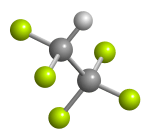Pentafluoroethane
| |||
| Names | |||
|---|---|---|---|
| IUPAC name
1,1,1,2,2-Pentafluoroethane | |||
| Other names
Pentafluoroethane, Genetron HFC 125, Khladon 125, Suva 125, Freon 125, Fc-125, R-125 | |||
| Identifiers | |||
3D model (JSmol) |
|||
| ChemSpider | |||
| ECHA InfoCard | 100.005.962 | ||
| EC Number | 206-557-8 | ||
PubChem CID |
|||
| |||
| |||
| Properties | |||
| C2HF5 | |||
| Molar mass | 120.02 g/mol | ||
| Appearance | Colourless gas | ||
| Density | 1.53 g/cm3 (liquid at -48.5 °C)[1] | ||
| Melting point | −103.0 °C (−153.4 °F; 170.2 K) | ||
| Boiling point | −48.5 °C (−55.3 °F; 224.7 K) | ||
| Vapor pressure | 1414.05 kPa (at 25 °C) | ||
Except where otherwise noted, data are given for materials in their standard state (at 25 °C [77 °F], 100 kPa). | |||
| Infobox references | |||
Pentafluoroethane is a refrigerant with the formula CF3CHF2. Although it has zero ozone depletion potential, it has high global warming potential, reported by the United States Environmental Protection Agency (EPA) as 3450 times that of carbon dioxide.[2]
Pentafluoroethane in a near zeotropic mixture with difluoromethane is known as R-410A, a common replacement for various chlorofluorocarbons (commonly known as Freon) in new refrigerant systems. Pentafluoroethane is also used as a fire suppression agent in fire suppression systems.
Fire suppression systems
HFC-125 (ECARO-25 / FE-25 / NAF S 125) is a gaseous fire suppression agent which can be used in clean agent fire suppression systems. It is generally used in situations where water from a fire sprinkler would damage expensive equipment, or where water-based fire protection is impractical, such as museums, banks, clean rooms and hospitals. HFC-125 does not deplete ozone (ODP 0). The HFC-125 clean agent is stored in a pressurized container and introduced into the hazard as a gas. The agent is odorless, colorless, electrically non-conductive, non-corrosive, and leaves no residue. It is used in occupied enclosed areas that contain high-value assets.
HFC-125 suppresses fire by absorbing heat energy at its molecular level faster than the heat can be generated, so the fire cannot sustain itself. It also forms free radicals to chemically interfere with the chain reaction of the combustion process. This makes it a highly effective fire fighting agent that is safe for people and causes no damage to equipment.
HFC-125 is a non-ozone depleting replacement for Halon 1301. In addition, HFC-125 leaves no residue on valuable equipment after discharge.[3]
HFC-125 is considered a Clean Agent and is therefore included in the National Fire Protection Association's 2001 - Standard for Clean Agent Fire Extinguishing Systems.
When introduced to the market HFC-125 was not considered safe for use in occupied spaces. The US EPA Significant New Alternative Policy (SNAP) listing reflected this. Following the introduction and acceptance of the PBPK model in the NFPA standard 2001 on Clean Agent Fire Extinguishing Systems 2004 Edition, the restriction was relaxed and now HFC-125 can be used in occupied hazards. Generally, class B (flammable liquid) hazards require concentrations that exceed the agent's no-observed-adverse-effect level (NOAEL) so extra precautions must be taken to avoid prolonged exposure to the agent.
At high temperatures, pentafluoroethane will decompose and produce hydrogen fluoride. This is observable as presence of sharp, pungent odour, which can be perceived in concentrations far below a dangerous level. Other decomposition products include carbonyl fluoride, carbon monoxide and carbon dioxide. Prior to re-entry of a room where HFC-125 system has been activated to suppress a fire, the atmosphere should be tested. An Acid Scavenging Additive added to pentafluoroethane is able to reduce the amount of hydrogen fluoride.
ECARO-25 is a registered trademark of Fike Corporation. FE-25 is a registered trademark of E. I. du Pont de Nemours and Company or its affiliates. NAF S 125 (HFC-125 plus Acid Scavenging Additive) is a trademark of Safety Hi-Tech.

